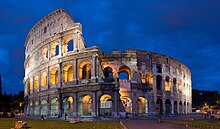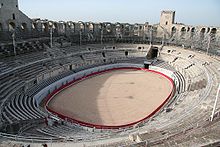amphitheater



An amphitheater ( Latin amphitheatrum ; from ancient Greek ἀμφιθέατρον ) is a round theater of Roman antiquity , typically without a closed roof, but can possibly be equipped with a sun sail. Rows of seats rise in stages around a round or oval arena .
Function and designation
In antiquity, an amphitheater was initially referred to as a building in which spectator stands ( θέατρον théatron ) were built around the location of a performance ( ἀμφί amphi ) . Therefore the name was also applied to the circus . Later it only referred to the venue for gladiatorial fights . Structurally, the amphitheater developed independently of the theater , even if the construction of the auditorium ( cavea ) clearly borrows from the ancient theater building. The largest amphitheater of antiquity, later known as the " Colosseum ", the "Flavian Amphitheater" in Rome , could accommodate up to 50,000 visitors.
The rising ranks of the theater were called maenianum . In most of the amphitheatres, the auditorium could be completely or at least partially covered with complicated awnings ( vela or velaria ). These sails were pulled up on masts, the anchorages of which were in the upper wall.
history
In the Roman Empire , the amphitheater was the setting for gladiator and animal fights ( munera et venationes ), but also for large theater performances and sporting competitions. With them, according to the motto “ bread and games ”, the people were kept happy. Amphitheaters often had sophisticated stage technology with which the superstructures could be lowered into the ground or they could even be completely filled with water.
At the time of Caesar , amphitheaters in Rome were still built of wood and demolished after the competitions. Around AD 27, one of these stands collapsed in Fidenae (east of Rome), killing thousands. This led to the fact that in future grandstands could only be built on solid ground, until finally stone amphitheaters were used. But even the Amphitheater Neronis , built in 57, was still made entirely of wood.
The first stone amphitheater existed in Campania as early as the late Republic. The oldest of its kind (around 60 BC) was found in Pompeii . It was called a spectacula . The name with the Greek word "amphitheater" is first found in Strabo , Flavius Josephus also mentions it in connection with Herod's building activity around 25 BC. The oldest mention of the word in Greek comes from the Libyan Berenike from the time around 8 to 6 BC. Most of the amphitheaters known today were located in the west of the Roman Empire and were built between the 1st and 3rd centuries AD. Few examples are known from the Greek east of the empire.
spectator
The spectators placed high bets on their fighters and were very committed to them. This often led to rivalries and arguments. In riots sponsors imposed Place Block .
Later buildings
Later (during the Baroque period ) there were also systems in Germany that were based on the shape of the ancient amphitheater and were used to organize animal fights, so u. a. in Berlin (the so-called " Hetzgarten "), in Königsberg, in Nuremberg ("Fechthaus") and in Vienna (" Hetztheater "). From an architectural point of view, the most famous successor buildings are the Spanish-Portuguese bullring from the 18th to the 20th century and the modern sports stadiums that are spread all over the world .
See also
literature
General
- Augusta Hönle , Anton Henze : Roman amphitheater and stadiums. Gladiator fights and circus games . Atlantis-Verlag, Zurich et al. 1981, ISBN 3-7611-0627-0 ( Edition ancient world ).
- Jean-Claude Golvin : L'amphithéâtre romain. Essai sur la théorisation de sa forme et de ses fonctions. 2 volumes. Boccard, Paris 1988 ( Publications du Center Pierre Paris 18, 1-2, ISSN 0339-1736 ).
- Claude Domergue (Ed.): Gladiateurs et amphithéatres. Actes du colloque tenu à Toulouse et à Lattes les 26, 27, 28 et 29 may 1987. Editions Imago, Lattes 1990, ISBN 2-9501586-6-8 ( Spectacula 1).
- Jean-Claude Golvin, Christian Landes: Amphithéâtres & gladiateurs. Presses du CNRS, Paris 1990, ISBN 2-87682-046-3 .
- Inge Nielsen: Amphitheater. In: The New Pauly (DNP). Volume 1, Metzler, Stuttgart 1996, ISBN 3-476-01471-1 , Sp. 619-624.
- David Lee Bomgardner: The story of the Roman amphitheater . Routledge, London et al. 2000, ISBN 0-415-16593-8 .
- Adriano La Regina (Ed.): Sangue e Arena. Milan, Electra 2001, ISBN 88-435-7981-9 (exhibition catalog, Rome, Colosseum, June 22, 2001 - January 7, 2002).
- Katherine E. Welch: The Roman amphitheater. From its origins to the Colosseum . Cambridge University Press, Cambridge et al. 2007, ISBN 978-0-521-80944-3 .
- Paul Jonas Meier : Amphitheater . In: Paulys Realencyclopadie der classischen Antiquity Science (RE). Volume I, 2, Stuttgart 1894, Col. 1959-1962.
Amphitheater in individual areas
- Jean-Claude Lachaux: Théatres et amphithéatres d'Afrique proconsulaire. Edisud, Aix-en-Provence 1979.
- Dorin Alicu, Coriolan Opreanu: Les amphithéâtres de la Dacie romaine. Editura Napoca Star, Cluj-Napoca 2000, ISBN 973-9455-62-X .
- Marin Buovac: Amphitheaters in the Republic of Croatia . 13th Annual Meeting of the European Association of Archaeologists, Sveučilište u Zadru, Zadar 2007.
- Thomas Hufschmid: Amphitheater in Provincia et Italia. Architecture and use of Roman amphitheaters from Augusta Raurica to Puteoli . 3 volumes. Roman Museum, Augst 2009, ISBN 978-3-7151-0043-2 ( research in Augst 43).
Amphitheater in Pula (front view)
Web links
- amphi-theatrum.de of the Regional Archeology Department Mainz (comprehensive collection of amphitheaters of antiquity sorted by country).







